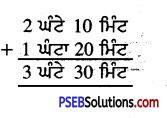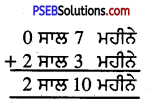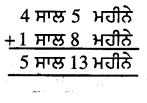Punjab State Board PSEB 5th Class Hindi Book Solutions Hindi Rachana Nibandh Lekhan निबंध-लेखन Exercise Questions and Answers, Notes.
PSEB 5th Class Hindi Rachana निबंध-लेखन (2nd Language)
मेरा घर
मेरा घर जालन्धर की बस्ती शेख में है। मेरा घर पक्की ईंटों से बना है। मेरा घर बहुत ही साफ़-सुथरा है। घर में प्रवेश करने के लिए काले रंग का एक बड़ा दरवाज़ा है। यह दरवाजा लोहे का है। बाहर की दीवारों का रंग हल्का हरा है। मैं अपने घर में माता-पिता, एक छोटे भाई और बहन के साथ रहता हूँ।
मेरे घर में चार कमरे हैं जिसमें एक बैठक और दो बैड रूम हैं तथा एक कमरा स्टोर रूम है जिसमें घर का फालतू सामान पड़ा रहता है। एक कमरा हम दो भाई-बहन का है। एक । रसोई घर तथा एक नहाने का छोटा कमरा भी है। रसोई घर में माता जी खाना बनाती हैं। हमारा कमरा बहुत सुन्दर है।
इसकी दीवारों का रंग हल्का पीला है। अपने कमरे में हमने अपनी तस्वीरें लगा रखी हैं। हमारा घर छोटा पर रोशनी वाला तथा हवादार है। मेरे घर में सुख-शान्ति का वास है क्योंकि घर में सभी प्यार से रहते हैं। मुझे मेरा घर बहुत प्रिय है।

मेरा मित्र
मोहन मेरा मित्र है। उसके पिता गाँव के नम्बरदार हैं। उसकी माता जी गाँव के प्राइमरी स्कूल में पढ़ाती हैं। मैं और मेरा मित्र मोहन पाँचवीं श्रेणी में एक ही स्कूल में पढ़ते हैं। हम दोनों समय पर स्कूल जाते हैं। श्रेणी के कमरे में बड़ी लगन के साथ पढ़ाई करते मैं और मेरा मित्र सफ़ाई का खास ध्यान रखते हैं।
हम दोनों हर रोज़ इकट्ठे ही खेलने जाते हैं। अक्सर हम दोनों स्कूल का काम मिल-जुल कर ही निपटाते हैं। हमारे अध्यापक हम दोनों पर बहुत खुश रहते हैं क्योंकि हम उनकी हर आज्ञा का पालन करते हैं। हम दोनों मित्र हर परीक्षा में अच्छे अंक लेकर पास होते हैं। मुझे अपने मित्र पर गर्व है। भगवान् ऐसा मित्र हर किसी को दे।
मेरा स्कूल
मेरे स्कूल का नाम ‘सरकारी प्राइमरी स्कूल’ है।
यह रेलवे स्टेशन के पास ही है। हमारे स्कूल में दस कमरे हैं। हर कमरे में हवा तथा रोशनी का पूरा प्रबन्ध है। सभी कमरों में बिजली के पंखे लगे हुए हैं। सभी कमरे बहुत अच्छे सजे हुए हैं। मेरे स्कूल में छोटा-सा बगीचा भी है। इसमें सुन्दर फूल खिले हुए हैं। इन फूलों से हमारे स्कूल की सुन्दरता और भी बढ़ जाती है। स्कूल में एक खेल का मैदान भी है। हम आधी छुट्टी के समय यहाँ खेलते हैं। हमारे स्कूल में सभी अध्यापक बहुत अच्छे हैं।
उनका पढ़ाने का ढंग बड़ा सरल है। इसलिए हमारे स्कूल के परिणाम सदा अच्छे रहते हैं। सच पूछो तो हमारा स्कूल हमारे नगर का सबसे अच्छा स्कूल है।
मेरा प्रिय अध्यापक
मेरे स्कूल में बहुत-से अध्यापक हैं। लेकिन श्री राजेन्द्र कुमार जी मुझे बहुत अच्छे लगते हैं। वह मेरे प्रिय अध्यापक हैं। उनके पढ़ाने का ढंग बहुत सरल है। वह विद्यार्थियों से बड़े प्रेम के साथ व्यवहार करते हैं।
उन्होंने उच्च शिक्षा प्राप्त की है। वह स्वयं उच्च विचारों वाले तथा नम्र-स्वभाव के व्यक्ति हैं। वह स्वयं भी सदा सत्य बोलते हैं और हमें भी सदा सत्य के पथ पर चलने की शिक्षा देते हैं। वह सदा समय पर स्कूल आते हैं।
वह बहुत ही दयालु हैं। वह गरीब तथा कमज़ोर बच्चों की सहायता भी करते हैं। वह एक अच्छे खिलाड़ी भी हैं इसी कारण वह हमें भी खेलने की प्रेरणा देते हैं। ईश्वर उनकी आयु लम्बी करे।

होली
होली रंगों का त्योहार है। होली घर-घर खुशियाँ बाँटती है। यह एक ऐसा त्योहार है, जिसमें न कोई. बड़ा होता है, न कोई छोटा माना जाता है। होली में जात-पात का भेद भी समाप्त हो जाता है। गाँव हो या शहर सब लोग मिल कर होली खेलते हैं। एकदूसरे पर गुलाल डालते हैं। प्यार से सभी होली की हुड़दंग मचाते हैं। होली के दिन सभी के चेहरे लाल, नीले, काले रंगों से रंगे होते हैं। होली पर एक-दूसरे को उपहार भी दिये जाते हैं। होली हमारे भाई-चारे को मज़बूत बनाती है। होली हमें भक्त प्रह्लाद की याद दिलाती है।
होली को वसन्त ऋतु का उपहार माना जाता है। यह त्योहार हम सब को सभी प्रकार के झगड़े खत्म करने की प्रेरणा देता है। आपसी भाईचारे को बढ़ाना ही होली का सच्चा सन्देश है।
जन्म दिन कैसे मनाया
इस बार मैंने अपना जन्म दिन बहुत ही सादगी से मनाया। यह मेरा नवम् जन्म दिन था। इस दिन प्रातः काल मैंने नहा धोकर नए कपड़े पहने और गुरुद्वारे में माथा टेकने गया। आते हुए मार्ग में शिव जी के मन्दिर में भी हो आया। मैंने अपने माता-पिता के चरण स्पर्श किए। उन्होंने मुझे दीर्घायु होने का आशीर्वाद प्रदान किया। मेरे माता-पिता और मेरी बहन ने मुझे सुन्दर-सुन्दर उपहार दिए और मैंने भी अपनी नन्हींसी प्यारी बहन को उपहार के रूप में गुड़िया प्रदान की। मेरे सभी मित्रों को मेरे जन्म दिन का पता एक दिन पहले ही चल गया था।
जन्म दिन के दिन शाम से ही मित्रों की मंडली मेरे घर आ पहुँची। किन्हीं के हाथों में गुलदस्ते थे तो किन्हीं के हाथों में उपहार के पैकेट। मेरा मन मित्र-मंडली को पाकर झूम उठा। मेरे माता जी ने चाय-पार्टी का पहले से ही प्रबन्ध कर रखा था। पिता जी स्वयं बढ़िया-बढ़िया मिठाइयाँ लेकर आए थे। सभी ने मुझे बधाइयाँ दीं। हमने केक काटा और गाने लगाकर खूब नाचे। हमने अपने जन्मदिन पर खूब मजा किया। इस बार का जन्मदिन मुझे सदा याद रहेगा।
मेरी श्रेणी का कमरा
मैं पाँचवीं श्रेणी का छात्र हूँ। अपने गाँव के स्कूल में पढ़ता हूँ। हमारा स्कूल तालाब के किनारे ऊँचे स्थान पर स्थित है। स्कूल में प्रवेश करते ही दाईं ओर मेरी श्रेणी का कमरा है। इसके बाहर रंग-बिरंगे फूलों की क्यारियाँ हैं। ये मेरे श्रेणी के कमरे की सुन्दरता को चार चाँद लगा रही हैं। मेरी श्रेणी का कमरा बहुत ही साफ़-सुथरा और शान्त है। किसी भी प्रकार का यहाँ कोई शोर नहीं है। इसी कारण सभी छात्रों का दिल पूरी तरह पढ़ाई में लगा रहता है।
‘मेरी श्रेणी का कमरा हवादार है। इसमें किसी प्रकार की घुटन अनुभव नहीं होती। गर्मियों में बिजली के पंखे हवा देते हैं। सर्दियों में खिड़कियाँ बन्द करके ठंडी हवा से बचाव होता है। श्रेणी के ऐसे कमरे प्रत्येक स्कूल में होने चाहिए। साथ ही हमें अपने श्रेणी के कमरे की स्वयं सफ़ाई का ध्यान रखना चाहिए।

दीवाली
दीवाली हमारे देश का एक पवित्र और प्रसिद्ध त्योहार है। यह त्योहार कार्तिक मास की अमावस्या को मनाया जाता है। यह दशहरे के बीस दिन बाद आता है। इस दिन भगवान् राम लंका के राजा रावण को मार कर तथा वनवास के चौदह वर्ष खत्म कर अयोध्या लौटे थे। तब लोगों ने उनके स्वागत में रात को दीये जलाए थे। उनकी पवित्र याद में यह दिन बड़े सम्मान से मनाया जाता है। इस दिन सिक्खों के छठे गुरु गुरु हरगोबिन्द जी ग्वालियर के किले से मुक्त होकर लौटे थे अतः इसलिए सिक्ख भी बड़े उत्साह से इस त्योहार को मनाते हैं।
दीवाली से कई दिन पहले ही इसकी तैयारी आरम्भ हो जाती है। लोग घरों की लिपाई-पुताई करते हैं। कमरों को सजाते हैं। घरों का कूड़ा-कर्कट बाहर निकालते हैं। अमावस को दीपमाला मनाई जाती है। – इस दिन लोग मित्रों को बधाई देते हैं और मिठाइयाँ बाँटते हैं।
बच्चे और युवा नए-नए वस्त्र पहनते हैं। रात को आतिशबाज़ी चलाते हैं। लोग रात को लक्ष्मी की पूजा करते हैं। कुछ लोग दुर्गा सप्तशति का पाठ भी करते हैं। दीवाली हमारा धार्मिक त्योहार है। इस दिन शराब आदि का सेवन नहीं करना चाहिए न ही इस दिन जुआ आदि खेलना चाहिए। इसकी पवित्रता बनाए रखने के लिए इसे उचित रीति से मनाना चाहिए।
दशहरा
दशहरा प्रमुख त्योहारों में से एक है। यह आश्विन मास की शुक्ला दशमी तिथि को मनाया जाता है। इस दिन श्री राम ने रावण पर विजय पाई थी। भगवान् राम के वनवास के दिनों में रावण छल से सीता को हर ले गया था। राम ने हनुमान और सुग्रीव आदि मित्रों की सहायता से लंका पर हमला किया तथा रावण को मार कर लंका पर विजय पाई। तभी से यह दिन मनाया जाता है।
दशहरा रामलीला का आखिरी दिन होता है। भिन्नभिन्न स्थानों में अलग-अलग प्रकार से यह दिन मनाया जाता है। हिमाचल में कुल्लू का दशहरा सबसे प्रसिद्ध है, वहाँ यह त्योहार कई दिनों तक मनाया जाता है। दशहरे के दिन रावण, कुम्भकर्ण तथा मेघनाथ के कागज़ के पुतले बनाए जाते हैं।
इस दिन कुछ लोग शराब पीते हैं और लड़ते हैं। यह ठीक नहीं। यदि ठीक ढंग से इस त्योहार को मनाया जाए तो बहुत लाभ हो सकता है।
वर्षा ऋतु
भारत में मई और जून की कड़कती गर्मी के बाद जुलाई और अगस्त में वर्षा का आगमन होता है। वर्षा का स्वागत किसान नाच-गा कर करते हैं, स्त्रियाँ झूला झूलती हैं तथा बच्चे नंग-धडंग हो कर वर्षा में गलियों और बाजारों में घूमते हैं। चारों तरफ हरियाली छा जाती है। जल ग्रहण कर पौधे और वृक्ष खुशी से झूम उठते हैं। तालाब और जौहड़ पानी से भर जाते हैं। जगह-जगह मेंढक टर-टराने शुरू हो जाते हैं।
नदी-नालों में बरसात का पानी भर जाने से नवयौवन का संचार हो जाता है। समय पर यदि अच्छी वर्षा हो जाए तो देश में अन्न का संकट टल जाता है। वर्षा ऋतु काफ़ी कष्टप्रद भी है। यह ऋतु अपने साथ अनेक मुसीबतें भी ले आती है। कई स्थानों पर बाढ़ें आ जाती हैं। भारी हानि होती है। वर्षा ऋतु में कई बीमारियाँ भी फैल जाती हैं। फिर भी वर्षा ऋतु का हमारे जीवन में बहुत महत्त्व है।

प्रातः भ्रमण
प्रातः भ्रमण शरीर को स्वस्थ रखने में महत्त्वपूर्ण भूमिका निभाता है। यह न केवल शरीर को स्वस्थ रखता है बल्कि चुस्ती-स्फूर्ति भी प्रदान करता है। प्रातःकाल सैर करने से सारा दिन काम करने में मन लगता है और थकान भी महसूस नहीं होती। मैं प्रतिदिन अपने मित्र मोहन के साथ प्रात:काल सैर के लिए निकलता हूँ। वह सुबह मेरे घर आता है फिर हम इकट्ठे ही सैर को निकल पड़ते हैं।
रास्ते में कई और लोग सैर के लिए जाते हुए मिलते हैं। हम एक बाग़ में पहुँच कर थोड़ा सैर करते हैं फिर कुछ व्यायाम करते हैं। बाग़ में सुबह के समय सुन्दर और ताजी हवा चलती है। फूलों की सुगन्ध से सारा
वातावरण महक उठता है। घास, फूलों और पत्तियों पर ओस की बूंदें मोतियों के समान चमकती हैं। हम कुछ देर हरी-हरी घास पर नंगे पाँव चलते हैं। ऐसा करने से आँखों की रोशनी बढ़ती है। कुछ समय पश्चात् सूर्य-देवता अपने दर्शन देने लगते हैं। प्रात:कालीन सूर्य की किरणें शरीर के लिए अच्छी होती हैं। थोड़ा विश्राम करने के पश्चात् हम घर की ओर चल पड़ते हैं। सुबह की सैर हमें नीरोग रखती हैं और हमारी बुद्धि भी तीक्षण होती है।
26 जनवरी-गणतन्त्र दिवस
26 जनवरी हमारा गणतन्त्र दिवस है। यह राष्ट्रीय उत्सवों में विशेष स्थान रखता है, क्योंकि भारतीय गणतन्त्रात्मक लोकराज का अपना बनाया संविधान इसी पुण्य तिथि को लागू हुआ था। इसी दिन सन् 1950. ई० को भारत में गर्वनर जनरल के पद की समाप्ति हुई थी और शासन का मुखिया राष्ट्रपति बनाया गया था।
सन् 1929 में जब लाहौर में कांग्रेस का अधिवेशन हुआ तो उसमें कांग्रेस के प्रधान श्री जवाहरलाल नेहरू बने थे। उन्होंने यह आदेश निकाला था कि 26 जनवरी के दिन प्रत्येक भारतवासी राष्ट्रीय झण्डे के नीचे खड़ा होकर प्रतिज्ञा करे कि हम भारत के लिए आज़ादी की मांग करेंगे और उसके लिए आखिरी. दम, तक संघर्ष (जद्दो-जहद) करेंगे। तब से हर साल 26 जनवरी का पर्व मनाने की परम्परा (रिवाज़) चल पड़ी।
चाहे यह समारोह देश के हर बड़े-छोटे शहर में बड़ी धूमधाम से मनाया जाता है परन्तु भारत की राजधानी दिल्ली में इसकी शोभा देखते ही बनती है। हर प्रदेश के लोकनर्तक दल लोक नाच तथा शिल्प, आदि का प्रदर्शन करते हैं। कई ऐतिहासिक महत्त्व की वस्तुएं भी दिखाई जाती हैं। भारत के सैनिक दस्ते भी इस अवसर पर अपनी शक्ति प्रकट-करते हैं। छात्र-छात्राएँ भी इसमें भाग लेती हैं और कला का प्रदर्शन करती हैं।
स्वतन्त्रता दिवस-15 अगस्त
आ प्यारे स्वतन्त्र देश आ, स्वागत करता हूँ तेरा।
तुझे देखकर आज हो रहा, प्रमुदित दूना मन मेरा।
15 अगस्त, सन् 1947 का दिन भारत के इतिहास में स्वर्ण अक्षरों में लिखा जाने योग्य है। उस दिन भारत माता की गुलामी के बन्धन टूक-टूक हुए थे। इस आज़ादी को प्राप्त करने के लिए अनेक देशभक्तों ने अपने प्राण न्योछावर कर दिए थे। पण्डित जवाहरलाल जी स्वतन्त्र भारत के पहले प्रधानमन्त्री बने।
संसद् भवन पर तिरंगा झण्डा लहराया गया था। उस दिन दिल्ली के लाल किले पर पं० जवाहर लाल नेहरू ने अपने हाथों से तिरंगा झण्डा लहराया था। लाखों लोगों ने उसमें भाग लिया। अब स्वतंत्रतादिवस के अवसर पर देश का वर्तमान प्रधानमंत्री दिल्ली में ध्वजारोहण करता है।

व्यायाम
व्यायाम शरीर को ठीक रखने का सबसे अच्छा साधन है। व्यायाम का अर्थ है- शरीर को हिलानाडुलाना। हमारा शरीर एक मशीन की भान्ति है। इसे ठीक रखना अति आवश्यक है। खेल खेलना, कुश्ती लड़ना और सैर करना ये सब व्यायाम ही हैं। _ व्यायाम करने से हमारे शरीर को अनेक लाभ होते हैं।
व्यायाम करने वाला मनुष्य कभी अति मोटा नहीं हो सकता। हमारी पाचन शक्ति बढ़ती है और अनेक रोगों से छुटकारा मिलता है। इससे शरीर को ताकत मिलती है और स्फूर्ति आती है। व्यायाम प्रायः खाली पेट करना चाहिए। इसके लिए प्रातःकाल का समय ही अच्छा होता है।
प्रात:काल की सैर सबसे अच्छा व्यायाम है। व्यायाम सदा खुली हवा में करना चाहिए। व्यायम सब को करना चाहिए। मुझे व्यायाम का बड़ा चाव है। मैं प्रतिदिन सैर करने जाता हूँ। किसी खुले मैदान में पहुँच कर मैं अपने मित्रों के साथ फुटबाल खेलता हूँ। मुझे किसी प्रकार का रोग नहीं है। शरीर भी हृष्ट-पुष्ट है। इसका एकमात्र कारण व्यायाम है।
हमारा देश
हमारे देश का नाम भारत है। यह हमारी मातृभूमि है। दुष्यन्त और शकुन्तला के पुत्र भारत के नाम पर इसका भारत नाम पड़ा। यह एक विशाल देश है। जनसंख्या की दृष्टि से यह संसार में दूसरे स्थान पर है। इसकी जनसंख्या 125 करोड़ से भी ज्यादा है। यहाँ पर अलग-अलग जातियों के लोग रहते हैं।
भारत के उत्तर में हिमालय है और शेष तीनों ओर समुद्र है। स्थान-स्थान पर हरे-भरे वन इसकी शोभा है। यह एक कृषि प्रधान देश है। यहाँ की 80% जनता गाँवों में रहती है। यहाँ गेहूँ, मक्का-बाजरा, ज्वार, चना, धान, गन्ना आदि फसलें होती हैं। यहाँ की धरती बहुत उपजाऊ है।
यहाँ गंगा-यमुना जैसी पवित्र नदियाँ बहती हैं। इसकी भूमि से लोहा, कोयला, सोना आदि कई प्रकार के खनिज पदार्थ निकलते हैं।
यहाँ पर कई धर्मों के लोग निवास करते हैं। सभी प्रेम से रहते हैं। यहाँ पर अनेक तीर्थस्थल हैं। ताजमहल, लालकिला, सारनाथ, शिमला, मंसूरी, श्रीनगर आदि पर्यटन स्थल हैं जो देखने योग्य हैं। यहाँ पर कई महापुरुषों ने जन्म लिया। राम-कृष्ण, गुरुनानक, दयानन्द, रामतीर्थ, तिलक, गांधी आदि इस देश की शोभा थे। यहाँ के राष्ट्रपति श्री रामनाथ कोविंद हैं। यह देश दिन दुगुनी रात चौगुनी उन्नति कर रहा है।

खेलों का लाभ
विद्यार्थी जीवन में खेलों का बड़ा महत्त्व है। पुस्तकों में उलझ कर थका-मांदा विद्यार्थी जब खेल के मैदान में जाता है तो उसकी थकावट तुरन्त गायब हो जाती है। विद्यार्थी अपने आप में चुस्ती और ताज़गी अनुभव करता है। मानव जीवन में सफलता के लिए मानसिक, शारीरिक शक्तियों के विकास से जीवन सम्पूर्ण बनता है। स्वस्थ, प्रसन्न, चुस्त और फुर्तीला रहने के लिए शारीरिक शक्ति का विकास ज़रूरी है। शरीर का विकास खेल-कूद पर निर्भर करता है।
यदि हम सारा दिन कार्य करते हैं तो शरीर में घबराहट, चिड़चिड़ापन या सुस्ती छा जाती है। ज़रा खेल के मैदान में जाइये, फिर देखिए घबराहट, चिड़चिड़ापन या सुस्ती कैसे दूर भागती है। शरीर हल्का-फुल्का और साहसी बन जाता है। मन में और अधिक कार्य करने की लगन पैदा होती है।
खेलों में भाग लेने से विद्यार्थी खेल के मैदान में से अनेक शिक्षाएं ग्रहण करता है। खेलें संघर्ष द्वारा विजय प्राप्त करने की भावना पैदा करती हैं। खेलें हँसते-हँसते अनेक कठिनाइयों पर विजय प्राप्त करना सिखा देती हैं। खेल के मैदान में विद्यार्थी के अन्दर अनुशासन में रहने की भावना पैदा होती है। सहयोग करने तथा भ्रातृभाव की आदत बनती है।
मेरा प्रिय खेल कबड्डी
आज हमारे भारत देश में अनेक खेल खेले जाते हैं। उन सब खेलों में कबड्डी का खेल मेरा प्रि: खेल है। यह खेल सब खेलों में सस्ता खेल है। आज यह खेल भी राष्ट्रीय खेल में गिना जाता है। यह दो प्रकार का है-पंजाबी कबड्डी और नेशनल कबड्डी।
यह खेल भी दो पक्षों में खेला जाता है। इस खेल की प्रत्येक टीम में सात खिलाड़ी होते हैं। यह खेल केन्द्र में रेखा डालकर खेला जाता है। यह खेल किसी खुले मैदान में खेला जाता है। इस खेल में यदि किसी एक खिलाड़ी का सांस टूट जाता है या विपक्ष के खिलाड़ी उसे छू लेते हैं या पकड़ लेते हैं तो रैफरी उसे मरा हुआ घोषित कर देता है। इस प्रकार विपक्ष एक अंक प्राप्त कर लेता है।
यदि वह खिलाड़ी दूसरे पक्ष के जितने खिलाड़ियों को छूकर अपने पक्ष में लौट आता है तो रैफरी विपक्ष के उतने ही खिलाड़ियों को मरा हुआ घोषित कर देता है। इस प्रकार यह बीस मिनट तक चलता है। बीस मिनट बाद रैफरी अर्धावकाश की सीटी मार देता है। अर्धावकाश पांच मिनट का होता है।
इस समय में खिलाड़ी जलपान करते हैं। इसके अतिरिक्त दोनों टीमों के प्रशिक्षक अपने खिलाड़ियों की गलतियों को बताते हैं। पाँच मिनट बाद रैफरी की सीटी के बाद फिर खेल उसी क्रम से शुरू होता है और बीस मिनट के बाद फिर समाप्त हो जाता है। पहले तथा दूसरे समय में जो टीम ज्यादा नंबर लेती है वही विजयी होती है।

ग्रीष्म ऋतु
बसन्त की समाप्ति पर ग्रीष्म का आगमन होता है। ग्रीष्म ऋतु ज्येष्ठ और आषाढ़ महीनों में पड़ती है। बसन्त में चलने वाली मन्द-मन्द हवा ग्रीष्म के आते ही गर्म हवा में बदल जाती है जिसे दूसरे शब्दों में ‘लू’ कहते हैं।
ग्रीष्म के प्रारम्भ होते ही दिन भी मानो गर्मी से फैलने लगते हैं। सूर्य का उदय शीघ्र ही हो जाता है और फिर अस्ताचल की ओर उसका गमन भी देर से होता है। दोपहर के समय तो मानो आकाश से अंगारे बरसते हैं। एक ओर जलती हुई लू तो दूसरी ओर जलाती हुई भूमि। इस समय बाहर निकलना भी एक समस्या बन जाता है। पशु-पक्षी भी इस समय पेड़ों के नीचे विश्राम करते हैं।






